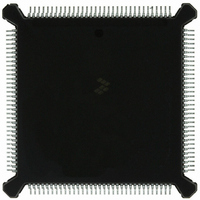MC68332GCEH16 Freescale Semiconductor, MC68332GCEH16 Datasheet - Page 143

MC68332GCEH16
Manufacturer Part Number
MC68332GCEH16
Description
IC MCU 32BIT 16MHZ 132-PQFP
Manufacturer
Freescale Semiconductor
Series
M683xxr
Specifications of MC68332GCEH16
Core Processor
CPU32
Core Size
32-Bit
Speed
16MHz
Connectivity
EBI/EMI, SCI, SPI, UART/USART
Peripherals
POR, PWM, WDT
Number Of I /o
15
Program Memory Type
ROMless
Ram Size
2K x 8
Voltage - Supply (vcc/vdd)
4.5 V ~ 5.5 V
Oscillator Type
Internal
Operating Temperature
-40°C ~ 85°C
Package / Case
132-QFP
Cpu Family
68K/M683xx
Device Core
ColdFire
Device Core Size
32b
Frequency (max)
16MHz
Interface Type
QSPI/SCI/UART
Program Memory Size
Not Required
Total Internal Ram Size
2KB
# I/os (max)
15
Number Of Timers - General Purpose
16
Operating Supply Voltage (typ)
5V
Operating Supply Voltage (max)
5.5V
Operating Supply Voltage (min)
4.5V
Instruction Set Architecture
RISC
Operating Temp Range
-40C to 85C
Operating Temperature Classification
Industrial
Mounting
Surface Mount
Pin Count
132
Package Type
PQFP
Controller Family/series
68K
No. Of I/o's
15
Ram Memory Size
2KB
Cpu Speed
16MHz
No. Of Timers
16
Embedded Interface Type
QSPI, SCI, UART
Digital Ic Case Style
PQFP
Rohs Compliant
Yes
Processor Series
M683xx
Core
CPU32
Data Bus Width
32 bit
Data Ram Size
2 KB
Maximum Clock Frequency
16 MHz
Number Of Programmable I/os
15
Number Of Timers
16
Maximum Operating Temperature
+ 85 C
Mounting Style
SMD/SMT
Minimum Operating Temperature
- 40 C
Lead Free Status / RoHS Status
Lead free / RoHS Compliant
Eeprom Size
-
Program Memory Size
-
Data Converters
-
Lead Free Status / Rohs Status
Compliant
Available stocks
Company
Part Number
Manufacturer
Quantity
Price
Company:
Part Number:
MC68332GCEH16
Manufacturer:
Freescale Semiconductor
Quantity:
10 000
MC68332
USER’S MANUAL
particular application. SCK is the serial clock input in slave mode. Assertion of the ac-
tive-low slave select signal SS initiates slave mode operation.
Before slave mode operation is initiated, DDRQS must be written to direct data flow
on the QSPI pins used. Configure the MOSI, SCK and PCS0/SS pins as inputs. The
MISO pin must be configured as an output.
After pins are assigned and configured, write data to be transmitted into transmit RAM.
Command RAM is not used in slave mode and does not need to be initialized. Unused
portions of QSPI RAM can be used by the CPU as general-purpose RAM. Initialize the
queue pointers as appropriate.
When SPE is set and MSTR is clear, a low state on the slave select (PCS0/SS) pin
begins slave mode operation at the address indicated by NEWQP. Data that is re-
ceived is stored at the pointer address in receive RAM. Data is simultaneously loaded
into the data serializer from the pointer address in transmit RAM and transmitted.
Transfer is synchronized with the externally generated SCK. The CPHA and CPOL
bits determine on which SCK edge to latch incoming data from the MISO pin and to
drive outgoing data from the MOSI pin.
Because the command control segment is not used, the command control bits and pe-
ripheral chip-select codes have no effect in slave mode operation. The PCS0/SS pin
is used only as an input.
The SPBR, DT and DSCK bits are not used in slave mode. The QSPI drives neither
the clock nor the chip-select pins and thus cannot control clock rate or transfer delay.
Because the BITSE option is not available in slave mode, the BITS field specifies the
number of bits to be transferred for all transfers in the queue. When the number of bits
designated by BITS has been transferred, the QSPI stores the working queue pointer
value in CPTQP, increments the working queue pointer, and loads new transmit data
from transmit RAM into the data serializer. The working queue pointer address is used
the next time PCS0/SS is asserted, unless the CPU writes to NEWQP first.
The QSPI shifts one bit for each pulse of SCK until the slave select input goes high. If
SS goes high before the number of bits specified by the BITS field is transferred, the
QSPI resumes operation at the same pointer address the next time SS is asserted.
The maximum value that the BITS field can have is 16. If more than 16 bits are trans-
mitted before SS is negated, pointers are incremented and operation continues. The
QSPI transmits as many bits as it receives at each queue address, until the BITS value
is reached or SS is negated. SS does not need to go high between
QSPI transfers data until reaching the end of the queue, whether SS remains low or is
toggled between transfers.
When the QSPI reaches the end of the queue, it sets the SPIF flag. If the SPIFIE bit
in SPCR2 is set, an interrupt request is generated when SPIF is asserted. At this point,
the QSPI clears SPE and stops unless wraparound mode is enabled.
Freescale Semiconductor, Inc.
For More Information On This Product,
QUEUED SERIAL MODULE
Go to: www.freescale.com
transfers,
as the
6-21











